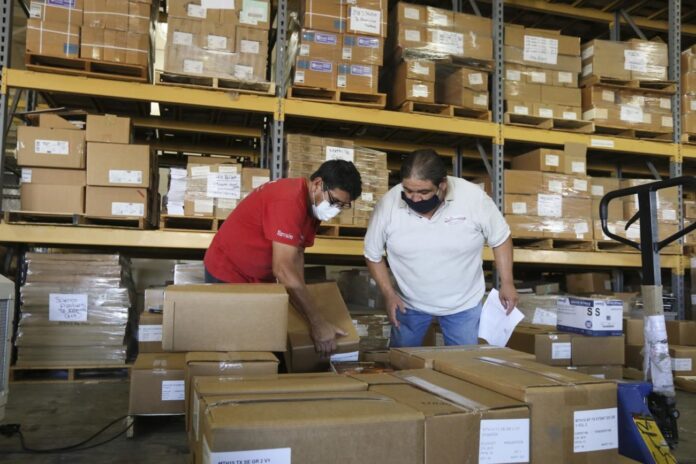Even if it wasn’t apparent then, the Brownsville Independent School Districtstarted laying the groundwork to begin the 2020-2021 school year 100% online soon after the COVID-19 pandemic reached Texas back in March; now it’s all hands on deck as BISD counts down to the first class day a week from Tuesday on Aug. 25.
The district’s Curriculum & Instruction and Business & Operations departments have worked virtually non stop since Spring Break to put all of the pieces in place to launch what will be an academic year unlike any other and still achieve the semblance of a normal school year.
The district has faced two big challenges: One, to make sure each of the 43,000 BISD students has a secure internet connection and an electronic learning device to access online lessons, via Seesaw on an iPad for younger students and Google Classroom on a Chromebook or other computer for third-grade and older students.
The other big challenge is to find all of the students, said Nereida Cantu, deputy superintendent for Business & Operations. Districts that have already started, including in Houston and San Antonio report this has been the biggest stumbling block for 100% online instruction.
Cantu urged parents to go to the BISD website, www.bisd.us, and complete the preference survey for the coming school year, or call BISD at (956) 548-8000. Surveys completed between May 20 and June 1 showed that 47 percent of BISD parents preferred traditional face-to-face learning, while 23 percent preferred a hybrid of in-person and online learning and 30 percent favored at-home digital instruction. Cantu said the data helps BISD make decisions about instruction and documentation of student participation is critical to funding.
Districts must be able to document student participation in classes in order to receive funding from the Texas Education Agency, so there’s a big incentive to make contact with all students on class rosters. Teachers, teachers’ aides, parent volunteers and others across the district are calling parents in an operation somewhat resembling a political campaign, Cantu said.

At the district warehouse on Morrison Road on Thursday and at individual campuses across the district everyone was pitching in to get school supplies ready to give out starting Monday at curbside distribution events. These include backpacks filled with workbooks and all the pens, paper, notebooks, markers and other items on the list of school supplies that parents normally have to buy this time of year.
BISD spent $1 million from fund balance for school supplies, although much of that will eventually be reimbursed through the CARES Act. BISD has also invested more than $6 million in technology devices, which include:
>> 11,000 Chromebooks
>> 6,000 iPads
>> 10,000 internet hotspots
>> 6,500 laptops
The Chromebooks were purchased using fund balance and are reimbursable through the CARES Act.
Of the 6,000 iPads, 4,000 will be purchased with local funding and reimbursed through the CARES Act. The remaining 2,000 iPads, 10,000 hotspots, and 6,500 laptops will also be purchased through local funding with assistance from TEA and the Dallas-area Operation Connectivity, which will provide a one-to-one match.

Students in Pre-K through second grade will receive iPads. Third-grade through high school students will receive Chromebooks. Laptops will be distributed to high schools in the Career and Technical Education program. Hotspots will be distributed one per family. Parents in need of a device or hotspot should contact their child’s campus principal.
The fact that BISD is able to start 100% distance learning at all is somewhat remarkable given that Brownsville ranks second in the nation for lack of broadband internet access, with an estimated 44 percent of households without a broadband subscription and more than 17 percent of households without a computer, according to an analysis of the U.S. Census by Business Insider.
By a unanimous vote on July 7 the Brownsville City Commission approved a $155,000 contract with Birmingham, Ala.-based consulting firm Lit Communities as the first step toward getting the city up to speed on broadband, which is able to handle massive amounts of digital data. BISD is part of a consortium of seven Brownsville entities backing the move.
Eventually, the group hopes to see Brownsville become one of the first fully wired cities in the country, with wireless internet access possible from anywhere in the city.
Brownsville is an advantageous position to achieve the goal because the city owns its own electric utility, the Brownsville Public Utilities Board, and BPUB owns rights of way throughout the city. Those rights of way can be used to broadcast internet signal to neighborhoods throughout the city, said Ramiro Gonzalez, the city’s director of government and community affairs.

Even today wireless internet, or Wi-Fi, is available at any of BISD’s 56 campuses during school hours because the district owns a pair of gigabyte-per-second trunk lines it uses to broadcast Wi-Fi services at the schools, said Philip T. Cowen, a member of the BISD Board of Trustees and chairman of the board’s Facilities Committee.
Wi-Fi capability is a key element in BISD’s ability to offer 100% online learning. Another is using district school buses as mobile hotspots. Twenty of the buses will be equipped with hotspots and then dispatched to parts of the city that lack reliable broadband internet, Cantu, the deputy superintendent, said. Students within 350 feet of the bus can then connect to the internet.





